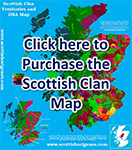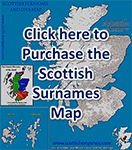You are here
Pinpointing your Scots-Irish origin from Autosomal DNA test Results!
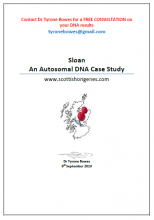 The Autosomal DNA test is by far the most popular commercial ancestral DNA test worldwide (tests like Ancestry.com’s, 23andMe, MyHeritage and FTDNA's Family Finder). BUT are you really getting the most from your Autosomal DNA test results? Rather than exhaustively looking to see how you connect to each individual match, maybe you should take a fresh approach, and look to where all these ancestral lines originate? We know that anyone who appears as an autosomal DNA match to you shares a male or female relative with you within the last 150-200 years. Here’s the thing, approximately half of your autosomal DNA matches ALSO reveal ancestral details (ancestral surnames and ancestral locations). That detail is NOT RANDOM: they literally reflect the relationships that developed among your various ancestral lines living in various locations within that last 200 years (and more, some of your genetic relatives record surnames and locations much older than the 200 year limit of shared DNA). If there is a Scots-Irish link then the autosomal DNA test results will reveal it! The results will even allow you to pinpoint a specific location within Ireland associated with your Scots-Irish ancestors, and in turn allow you to uncover where your Scots-Irish ancestor originated within Scotland!
The Autosomal DNA test is by far the most popular commercial ancestral DNA test worldwide (tests like Ancestry.com’s, 23andMe, MyHeritage and FTDNA's Family Finder). BUT are you really getting the most from your Autosomal DNA test results? Rather than exhaustively looking to see how you connect to each individual match, maybe you should take a fresh approach, and look to where all these ancestral lines originate? We know that anyone who appears as an autosomal DNA match to you shares a male or female relative with you within the last 150-200 years. Here’s the thing, approximately half of your autosomal DNA matches ALSO reveal ancestral details (ancestral surnames and ancestral locations). That detail is NOT RANDOM: they literally reflect the relationships that developed among your various ancestral lines living in various locations within that last 200 years (and more, some of your genetic relatives record surnames and locations much older than the 200 year limit of shared DNA). If there is a Scots-Irish link then the autosomal DNA test results will reveal it! The results will even allow you to pinpoint a specific location within Ireland associated with your Scots-Irish ancestors, and in turn allow you to uncover where your Scots-Irish ancestor originated within Scotland!
The following analysis and images are taken from the ‘Sloan Autosomal DNA Case study’ which can be downloaded for free and studied by CLICKING HERE.
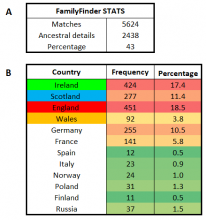 A simple exercise can demonstrate the ‘NON-RANDOM’ nature of that ancestral information revealed by your autosomal genetic relatives, you can blast search the ancestral detail recorded by your genetic relatives for references to specific countries (e.g. Ireland, Scotland, Wales, England, France, Germany etc., see accompanying image). Once you have identified a specific country, in this instance ‘Ireland,’ you can break it down even further and identify provinces or counties within that country. In this instance a search of Irish counties detailed among the ancestral information recorded by the autosomal matches revealed DNA hotspots in Antrim and Tyrone in Ulster, and Cork in Munster (see accompanying image).
A simple exercise can demonstrate the ‘NON-RANDOM’ nature of that ancestral information revealed by your autosomal genetic relatives, you can blast search the ancestral detail recorded by your genetic relatives for references to specific countries (e.g. Ireland, Scotland, Wales, England, France, Germany etc., see accompanying image). Once you have identified a specific country, in this instance ‘Ireland,’ you can break it down even further and identify provinces or counties within that country. In this instance a search of Irish counties detailed among the ancestral information recorded by the autosomal matches revealed DNA hotspots in Antrim and Tyrone in Ulster, and Cork in Munster (see accompanying image). 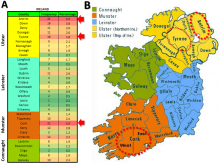 An examination of the ancestral surnames recorded by Mr Sloan's autosomal genetic relatives with recorded ancestral links within Ireland reveals that they are not random; the surnames recorded within Antrim and Tyrone are dominated by Scottish surnames (like Armstrong, Johnston and McClelland), while those with recorded links within County Cork are of Gaelic Irish origin (Kelly, Sullivan, McCarthy). This simple analysis reveals a Scots-Irish link for the test subject within counties Antrim and Tyrone in Ulster in Northern Ireland. In addition, some of one’s autosomal genetic relatives may also record locations associated with their Antrim or Tyrone ancestors, those locations are not random; plot them and they will localise to a specific area within those counties.
An examination of the ancestral surnames recorded by Mr Sloan's autosomal genetic relatives with recorded ancestral links within Ireland reveals that they are not random; the surnames recorded within Antrim and Tyrone are dominated by Scottish surnames (like Armstrong, Johnston and McClelland), while those with recorded links within County Cork are of Gaelic Irish origin (Kelly, Sullivan, McCarthy). This simple analysis reveals a Scots-Irish link for the test subject within counties Antrim and Tyrone in Ulster in Northern Ireland. In addition, some of one’s autosomal genetic relatives may also record locations associated with their Antrim or Tyrone ancestors, those locations are not random; plot them and they will localise to a specific area within those counties.
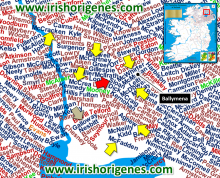 Once an area associated with your Scots-Irish (Antrim, Tyrone) has been identified, the challenge is then to link your ancestral surname with an autosomal DNA identified location. In this instance, the test subject was interested in his Scots-Irish ‘Sloan’ paternal ancestors. His Sloan ancestors were attracted to Ireland in around 1600AD by the availability of land (the same reason would entice many of them to America 100 years later). They would clear the land and pass it to their descendants, and it is no surprise to find that the Plantation Scots-Irish Sloan surname still concentrates in the areas where they first settled within Ireland. An examination of the Scots-Irish Sloans (Protestant farmers, male heads of household) in early Irish census data reveals a cluster in Antrim which gave the greatest signal from the test subject’s autosomal DNA results, see accompanying image. The autosomal DNA test results link the test subject’s Scots-Irish Sloans to the farmland of Midwest Antrim; where he can either pick up the ancestral papertrail or target Sloans for DNA testing (to confirm the ancestral link).
Once an area associated with your Scots-Irish (Antrim, Tyrone) has been identified, the challenge is then to link your ancestral surname with an autosomal DNA identified location. In this instance, the test subject was interested in his Scots-Irish ‘Sloan’ paternal ancestors. His Sloan ancestors were attracted to Ireland in around 1600AD by the availability of land (the same reason would entice many of them to America 100 years later). They would clear the land and pass it to their descendants, and it is no surprise to find that the Plantation Scots-Irish Sloan surname still concentrates in the areas where they first settled within Ireland. An examination of the Scots-Irish Sloans (Protestant farmers, male heads of household) in early Irish census data reveals a cluster in Antrim which gave the greatest signal from the test subject’s autosomal DNA results, see accompanying image. The autosomal DNA test results link the test subject’s Scots-Irish Sloans to the farmland of Midwest Antrim; where he can either pick up the ancestral papertrail or target Sloans for DNA testing (to confirm the ancestral link).
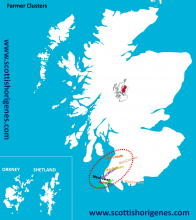 But that is not all! It is even possible to link one’s Scots-Irish ancestors back to their original Scottish homeland! The settlers that arrive in Ireland from the 1600AD onwards often departed together and settled together within Ireland. Hence the surnames of the Plantation community of Midwest Antrim are a mirror image of those from their Scottish homeland.
But that is not all! It is even possible to link one’s Scots-Irish ancestors back to their original Scottish homeland! The settlers that arrive in Ireland from the 1600AD onwards often departed together and settled together within Ireland. Hence the surnames of the Plantation community of Midwest Antrim are a mirror image of those from their Scottish homeland. 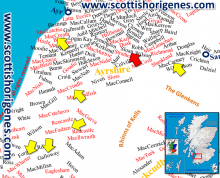 One can therefore examine the surnames that surround one’s Scots-Irish ancestors in the autosomal DNA revealed Irish location, and determine their original Scottish origin! To assist in that process I produced the first ever Plantation Surnames of Ireland map (click to preview). That map reveals the Sloans of Midwest Antrim surrounded by predominantly Scottish Gaelic surnames. An examination of a selection of those surnames reveals that they are exclusive to Southwest Scotland (see accompanying image).
One can therefore examine the surnames that surround one’s Scots-Irish ancestors in the autosomal DNA revealed Irish location, and determine their original Scottish origin! To assist in that process I produced the first ever Plantation Surnames of Ireland map (click to preview). That map reveals the Sloans of Midwest Antrim surrounded by predominantly Scottish Gaelic surnames. An examination of a selection of those surnames reveals that they are exclusive to Southwest Scotland (see accompanying image). 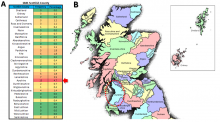 While an examination of the surnames of Southwest Scotland (as they appear on the Scottish Origenes Surnames of Scotland Map) reveals that the test subject’s Sloan ancestors lived close to the modern town of Ayr (see accompanying image). Furthermore, an examination of the Scottish counties recorded by the test subject's autosomal DNA genetic relatives with recorded links within Scotland also confirmed an ancestral link with Ayrshire (see accompanying image).
While an examination of the surnames of Southwest Scotland (as they appear on the Scottish Origenes Surnames of Scotland Map) reveals that the test subject’s Sloan ancestors lived close to the modern town of Ayr (see accompanying image). Furthermore, an examination of the Scottish counties recorded by the test subject's autosomal DNA genetic relatives with recorded links within Scotland also confirmed an ancestral link with Ayrshire (see accompanying image).
Finally, commercial ancestral Y-DNA testing confirmed (beyond a doubt) that the test subject’s Sloan paternal line originated within Ayrshire in Southwest Scotland CLICK HERE to view Mr Sloan's Scottish Origenes Y-DNA Case Study.
What will your DNA reveal? Contact Scottish Origenes (CLICK HERE or email: tyronebowes@gmail.com) for a FREE CONSULTATION on your DNA results or to find out about commercial ancestral DNA testing and a suitable test for you. Remember folks! Your DNA results are produced in a scientific lab, and worked on by trained scientists. Always check the qualifications of that blogger or person giving DNA advice (an honorary qualification is not equivalent to hard work and years of scientific experience).


